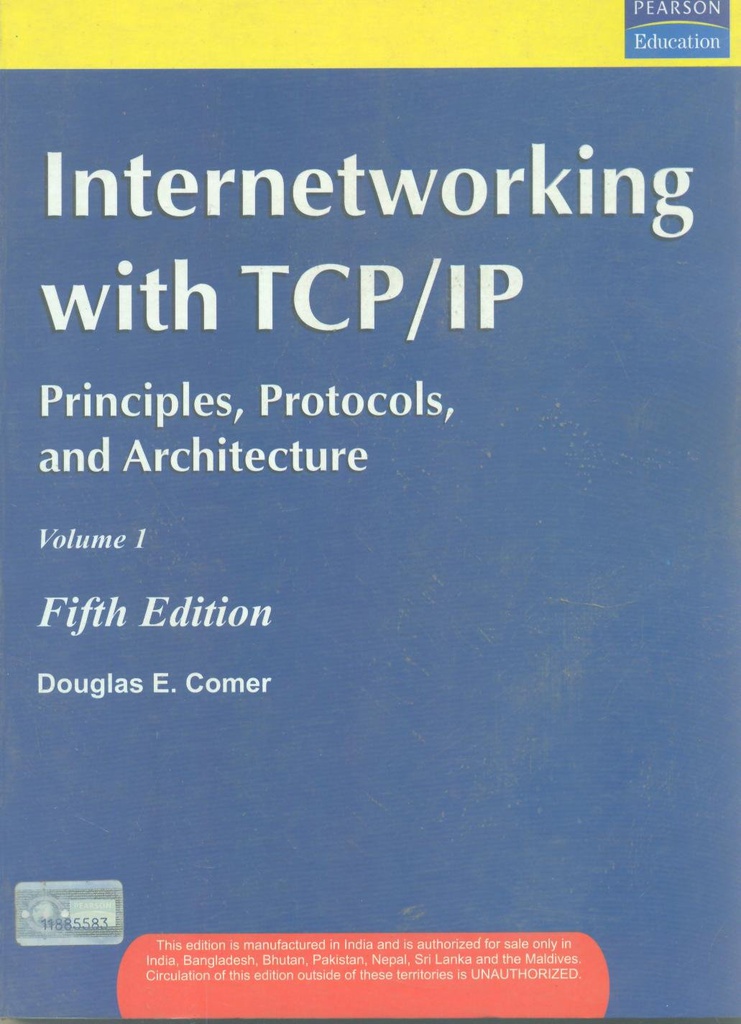Internetworking with TCP/IP: Principles, Protocols and Architecture, Vol. 1, 5/e
For courses in Computer Networks, Data Networks, Network Protocols, and Internetworking. This best-selling, conceptual introduction to TCP/IP internetworking protocols interweaves a clear discussion of fundamentals with the latest technologies. Leading author Doug Comer covers layering and shows how all protocols in the TCP/IP suite fit into the five-layer model. With a new focus on CIDR addressing, this revision addresses MPLS and IP switching technology, traffic scheduling, VOIP, Explicit Congestion Notification (ECN), and Selective ACKnowledgement (SACK).
Table of Content
- Introduction And Overview
- Review Of Underlying Network Technologies
- Internetworking Concept And Architectural Model
- Classful Internet Addresses
- Mapping Internet Addresses To Physical Addresses (ARP)
- Internet Protocol: Connectionless Datagram Delivery
- Internet Protocol: Forwarding IP Datagrams
- Internet Protocol: Error And Control Messages (ICMP)
- Classless And Subnet Address Extensions (CIDR)
- Protocol Layering
- User Datagram Protocol (UDP)
- Reliable Stream Transport Service (TCP)
- Routing Architecture: Cores, Peers, And Algorithms
- Routing Between Peers (BGP)
- Routing Within An Autonomous System (RIP, OSPF)
- Internet Multicasting
- IP Switching And MPLS
- Mobile IP
- Private Network Interconnection (NAT, VPN)
- Client-Server Model Of Interaction
- The Socket Interface
- Bootstrap And Autoconfiguration (DHCP)
- The Domain Name System (DNS)
- Remote Login And Desktop (TELNET, SSH)
- File Transfer And Access (FTP, TFTP, NFS)
- Electronic Mail (SMTP, POP, IMAP, MIME)
- World Wide Web (HTTP)
- Voice And Video Over IP (RTP, RSVP, QoS)
- Network Management (SNMP)
- Internet Security And Firewall Design (IPsec, SSL)
- A Next Generation IP (IPv6)
- Appendix 1: A Look At RFCs 582
- Appendix 2: Glossary Of Internetworking Terms and Abbreviations Bibliography
Salient Features :
- Voice and Video Over IP (RTP) – Examines the RTP protocol that allows a receiver to coordinate and play real-time data such as voice and video as well as the RSVP and COPS protocols that can be used to provide resource information.
- IP coverage – Up-to-date discussions of Internet Security and Firewalls, Design with IPSEC, the latest IPv6 features, and IP Routing.
- Discussion of routing architectures – Elaborates on the routing architectures used for large and small Internets.
- Examination of Internet application services – Provides students with information on services such as domain name system (DNS), electronic mail (SMTP, MIME), file transfer and access (FTP, TFTP, NFS), remote login (TELNET, rlogin), and network management (SNMP, MIB, ANS.I).
- Mobile IP – Describes the technology that allows a computer to move from one network to another without changing its IP address.
- Private Network Interconnection (NAT, VPN) – Teaches students about two key technologies used to interconnect private intranets and the global Internet.
| Book | |
|---|---|
| Author | Douglas E. Comer |
| Pages | 684 |
| Year | 2007 |
| ISBN | 9788131706237 |
| Publisher | Pearson |
| Language | English |
| Uncategorized | |
| Edition | 5/e |
| Weight | 250 g |
| Dimensions | 20.3 x 25.4 x 4.7 cm |
| Binding | Paperback |


